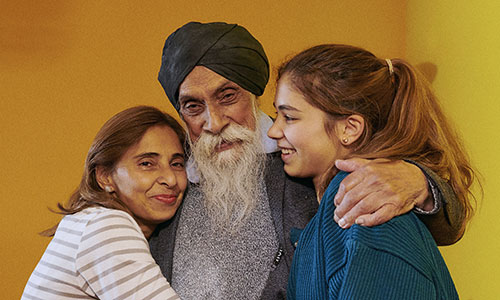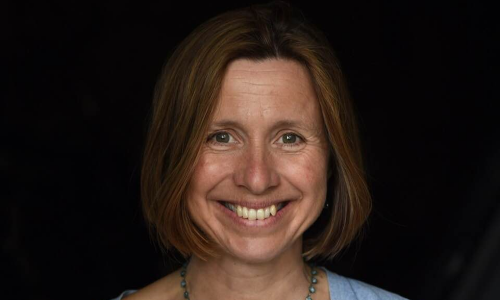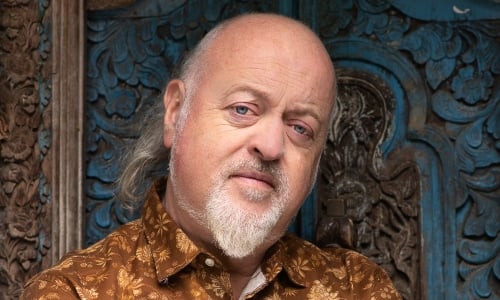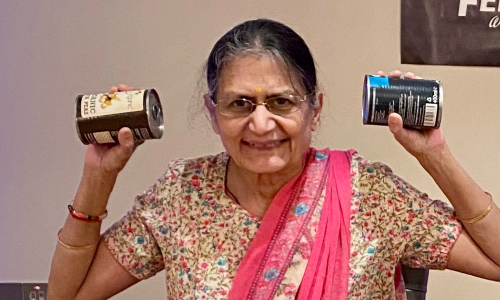Sandra Shaw (pictured below) appears with comedian Bill Bailey in Freedom To Move, a new series of videos from We Are Undefeatable.
Speaking to Age UK, Sandra discusses her fitness journey, the importance of the campaign, and everyday exercises older people can do to aid fitness and independence.
“Having a good quality of life will help with our mental wellbeing as well as our physical wellbeing,” Sandra tells us. “And if we keep moving it helps to stave off some of the conditions that can come with ageing. I always say that exercise is a great form of medication that helps you to move better, be stronger, and therefore be more confident.”
What was your own fitness journey like?
 Sandra (pictured): “When I was younger, I was always very active. I used to do a lot of sports and would train in dance about 4-5 times a week, so that was all I knew. It helped with my confidence, to develop me as an individual, without me becoming aware of it. Given my love of music, I decided instead to learn how to teach group exercise, which I did for several years.
Sandra (pictured): “When I was younger, I was always very active. I used to do a lot of sports and would train in dance about 4-5 times a week, so that was all I knew. It helped with my confidence, to develop me as an individual, without me becoming aware of it. Given my love of music, I decided instead to learn how to teach group exercise, which I did for several years.
“I thoroughly enjoyed it but what I noticed was that when there were people in the classes who didn’t have the same physical ability, I wasn’t able to cater for their needs because I didn’t know how to. That’s when I decided I wanted to train to be able to help the one or two individuals who came to class and had physical limitations. I took several courses that gave me the expertise to work with people who had a number of long-term or physical conditions, though I still did that in a group setting.
“After doing that for several years, my daughter developed three autoimmune conditions. I decided to work with her one-to-one and saw the benefits to her. That’s what brought me to where I am today.”
What were some of your early victories working with people with long-term health conditions?
“I used to work in cardiac rehabilitation and with people who’d had strokes. Often, someone might not have much confidence because of what they'd been through and would be worried about exerting themselves in case it triggered some kind of response, especially if someone had heart failure. As time went on, we did some exercises and there would be small challenges along the way, but as they overcame those challenges, their confidence would develop, and you’d see them becoming stronger.
“If you’ve had a fall that can be quite life-changing for some older adults. Your confidence can be lost and you can become very worried about going out, so you change how you live. The aim, then, is to get people back to that life. Watching someone who's had a fall go from gripping on to something for dear life because they couldn’t balance on one leg, to developing the strength to take walks outside without a walking aid is really rewarding, because it’s enabled that person to have more independence and improved their quality of life.
“What’s more, because of the benefits of exercise, you find that people continue with it because it’s making a difference, so they don’t go back to a more sedentary lifestyle.”
Why do you think We Are Undefeatable is so important?
“The campaign is something very close to my heart because it’s reaching out to people who do not necessarily access mainstream exercise – and for a few reasons you may not feel you can exercise. There’s a whole group within our communities who feel as though they can’t do it because you have various conditions or may feel self-conscious going to a gym.
“The We Are Undefeatable campaign shows that whatever your physical limitations might be, there is a way you can exercise because our bodies like to move. You can exercise seated – you can do 5 minutes a day, 10 minutes a day – at any time of day that works for you. You can do stuff that’s specific to you, that isn't too demanding on the joints and allows you to take a breather when you need to.”
Mental health can present a big barrier for people, too…
“If you’ve had a health diagnosis that you weren’t expecting, it can come as a shock to the system and make people feel as though you’re not able to do anything, or don’t want to do anything, which starts to slow people’s response to any kind of movement. People may also feel too tired. This can lead to people using a very negative language about themselves, which you start to believe.”
What’s your initial approach for someone who has started thinking negatively?
“I usually ask someone: ‘Can you think of something that you really enjoy doing?’ Someone may enjoy walking, just popping down to the post box or having a chat with a neighbour over the fence. In finding out something that’s enjoyable, you’re already bringing those positive thoughts and feelings back. Then I’d ask the individual what you’d like to be able to achieve, before building little stepping stones towards that goal.
“If, for example, someone is finding it difficult to get out of a chair, I suggest bringing yourself to the edge of the chair, and using the support of its arms, bring yourself to a standing position. Taking as much time as you need, take a couple of steps back so you can feel the back of the chair against your legs and sit down carefully.
“If you can’t stand, go as far as feels comfortable for you. In time you will build strength. That starts to build confidence and the belief you can do the things you’ve worried about, at a timescale that works for you. If there’s a day you can't do something, or don’t want to, then that’s fine – tomorrow is a new day for you to give it a try.”
Have you noticed specific challenges for older people since the pandemic?
“There has been a change, as people lost their routines for so long and social networks have declined for one reason or another. Many older people also feel lonely and isolated, and because they haven’t been as mobile as they used to be, they are becoming physically weaker in the lower body and balance has been impacted.
“If you lose balance and have a fall, which means you then must then call someone to ask for help with something, you already feel you’re losing some ability – and that massively impacts confidence. I therefore teach older people exercises that mean they can look after themselves to strengthen themselves, which makes them think, ‘I’m more in control of my life’.”
What are a couple of everyday exercises you recommend for older people wanting to maximise strength?
“One of the key things for balance and strength is having strong legs. It’s therefore important to strengthen those muscles around the knees to reduce aches and pains. One exercise for that is leg extensions, which you can do by sitting in the chair with your back up nice and tall and your feet flat on the floor. Then you slowly bring a leg up so it’s straight in front of you, hold them out for a count of 3, then bring them down. Doing that 8-10 times with each leg will help strengthen the muscles around the knees. The key thing is to do them slowly.
“Another thing to do, while still sitting in the chair, is to reach down to the side of the chair, as if you’re picking a cup or newspaper up off the floor, but making sure you’re still facing the front while bringing the tummy muscles in. After reaching down for a few seconds, you come back to the centre. This exercises the muscles around the stomach, the core, which is good for keeping you upright, while doing a bit of work around the spine. It’s great to do this exercise 8-10 times on each side.”
What words of encouragement would you offer for older people starting out with exercise?
“I would say you should be proud of your age, and it shouldn’t stop you doing anything. Whatever your age or physical limitations, there is a movement you can do. Always try and do something little and often, whether it’s walking up and down the stairs while holding the banister or walking up and down just one step if that’s all you can manage. Maybe next week you can do two steps!”
How to keep moving
It's a myth that getting older means an end to being active. We can offer guidance on how to stay moving, whatever your age.






